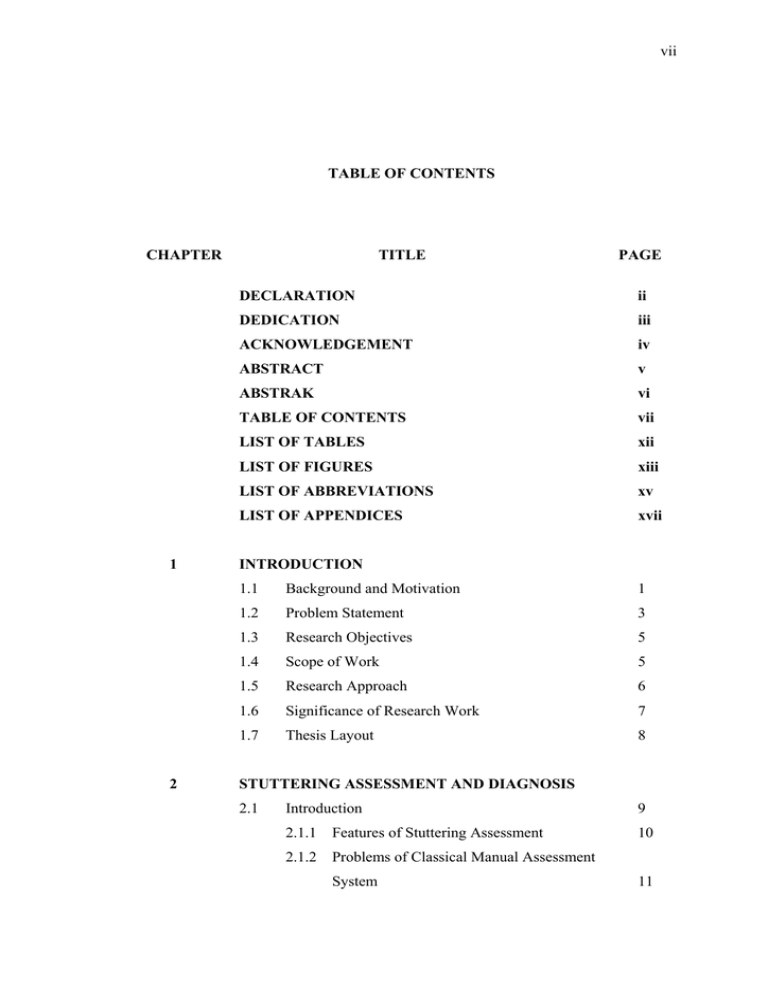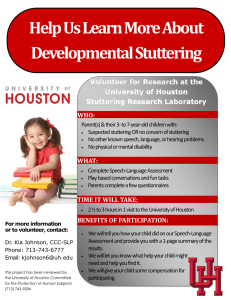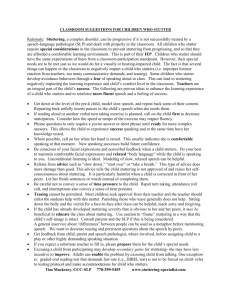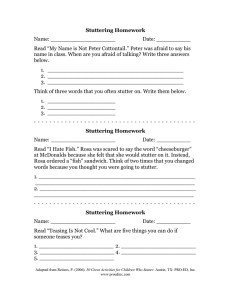vii TABLE OF CONTENTS CHAPTER
advertisement

vii TABLE OF CONTENTS CHAPTER 1 2 TITLE PAGE DECLARATION ii DEDICATION iii ACKNOWLEDGEMENT iv ABSTRACT v ABSTRAK vi TABLE OF CONTENTS vii LIST OF TABLES xii LIST OF FIGURES xiii LIST OF ABBREVIATIONS xv LIST OF APPENDICES xvii INTRODUCTION 1.1 Background and Motivation 1 1.2 Problem Statement 3 1.3 Research Objectives 5 1.4 Scope of Work 5 1.5 Research Approach 6 1.6 Significance of Research Work 7 1.7 Thesis Layout 8 STUTTERING ASSESSMENT AND DIAGNOSIS 2.1 Introduction 9 2.1.1 Features of Stuttering Assessment 10 2.1.2 Problems of Classical Manual Assessment System 11 viii 2.1.3 2.2 2.3 2.4 Computer-based Assessment System The Variability of Fluency 14 2.2.1 Definition of Stuttering 15 2.2.2 Characteristics of Stuttering 18 2.2.3 Types of Stuttering 22 Basic Considerations When Assessing Young Children 23 Formal Measures of Assessment System 25 2.4.1 Stuttering Severity Instrument (SSI-3) 25 2.4.2 Modified Erickson Scale of Communication Attitudes (S-24) 26 2.4.3 Perception of Stuttering Inventory (PSI) 26 2.4.4 Locus of Control Behaviour (LCB) 27 2.4.5 Crowe’s Protocols 2.4.6 2.4.7 2.5 2.6 3 12 27 Communication Attitude Test-Revised (CAT-R) 28 A-19 Scale for Children Who Stutter 28 Stuttering Therapy Techniques 29 2.5.1 Shadowing 30 2.5.2 Metronome 30 2.5.3 DAF 31 2.5.4 Rate Control 32 2.5.5 Regulated Breathing (RB) 32 2.5.6 Easy onset 33 2.5.7 Counselling 33 2.5.8 Prolonged Speech (PS) 34 Summary 34 STUTTERING ASSESSMENT FRAMEWORK DESIGN 3.1 Introduction 35 3.2 Assessment Requirement: Principles and Strategies 35 3.3 Variables in Choosing Therapy Techniques 36 3.3.1 The Therapy History of Client 37 3.3.2 The Age and Motivation Level of Client 37 ix 3.4 3.5 3.3.3 Economic and Time Constraints 38 3.3.4 SLP’s Beliefs 39 Basic Stuttering Treatment Approaches 39 3.4.1 Fluency Shaping (FS) 41 3.4.2 Stuttering Modification (SM) 42 3.4.3 Why Fluency Shaping (FS)? 43 Problem Formulation 44 3.5.1 44 The Uniqueness of Each Individual 3.5.2 Difficulty in Identifying Appropriate Therapy Technique 3.5.3 Time Consumption in Classical Manual Assessment System 3.6 4 45 46 3.5.4 Validity 47 Underlying Design Principles 48 3.6.1 Audio and Visual Feedbacks 49 3.6.2 50 Monitoring and Assessment 3.6.3 Clinical Evaluation 51 3.6.4 Motivation 52 3.7 System Design 54 3.8 Criteria for Selection of Scoring Parameters 55 3.9 Summary 57 DEVELOPMENT OF COMPUTER-BASED STUTTERING ASSESSMENT SYSTEM 4.1 Introduction 58 4.2 System Requirements 58 4.2.1 Hardware Requirements 59 4.2.2 Software Requirements 59 4.3 System Descriptions 59 4.4 Coding 62 4.4.1 Audio File Format 63 4.4.2 Sampling 63 4.4.3 Resolution Bit 64 4.4.4 Mono Channel 65 x 4.4.5 DC Offset Removal 65 4.4.6 Windowing 67 4.4.7 Time Domain Filtering 69 4.4.8 Recording and Playback of Speech Utterances 70 4.4.8.1 Playback 71 4.4.8.2 Recording 71 Background Noise Level Detection 72 4.4.9 4.4.10 History File 73 4.4.11 Client Identification 73 4.4.12 Compression and Decompression Using Speex 74 4.5 4.6 5 4.4.12.1 Encoding 77 4.4.12.2 Decoding 78 Scoring 79 4.5.1 Start Location 80 4.5.2 End Location 80 4.5.3 Maximum Magnitude 82 4.5.4 Duration 83 Summary 85 CLINICAL EVALUATION OF COMPUTER-BASED STUTTERING ASSESSMENT SYSTEM 5.1 Introduction 5.2 Implementing Clinical Trials among School-age 86 Children 86 5.2.1 Test Subjects 87 5.2.2 Experimental Set-Up 88 5.2.3 Scenario 89 5.2.3.1 Shadowing Task 90 5.2.3.2 Metronome Task 90 5.2.3.3 DAF Task 91 5.3 Assessment Procedures 92 5.4 Data Collection 101 5.5 Results or Quantitative Analyses 102 5.5.1 104 Results Generated by Software xi 5.5.2 Results Analysis by SLP 5.5.3 Comparison between Software and SLP 5.5.4 5.6 6 110 Analyses 111 Description of Individual Test Subjects 113 Summary 114 CONCLUSION 6.1 Introduction 115 6.2 Future Works 117 REFERENCES 119-127 Appendices A-I 128-172 xii LIST OF TABLES TABLE NO. 5.1 TITLE Occurrence Frequency of Stuttering Behaviours in Test Subjects 5.2 PAGE 103 The Range and Quartile Distribution of the Frequency Indices for Stuttering Characteristics 104 5.3 Software Scoring for Test Subjects 105 5.4 Software Scoring for Control Data 105 5.5 %SS for Each Therapy Technique 111 5.6 Comparison between the Determination of Therapy Technique 5.7 for Each Test Subject by Software and SLP 112 Description of Individual Test Subjects 113 xiii LIST OF FIGURES FIGURE NO. TITLE 1.1 Research Development Process 2.1 Speech Waveforms and Sound Spectrograms of a Male Client Saying “PLoS Biology” 3.1 PAGE 7 17 Comparisons between Fluency Shaping and Stuttering Modification 40 3.2 Five Steps to Implementing EBP 52 4.1 System Block Diagram 61 4.2 Flowchart: DC Offset Removal 67 4.3 Common Window Functions 68 4.4 Flowchart: Background Noise Level Detection 72 4.5 Dialog Box: The Loading of Wave Files 74 4.6 Dialog Box: Client Identification 74 4.7 Wave File Information 76 4.8 Speex File Information 76 4.9 Encoding Process 77 4.10 Decoding Process 78 4.11 Flowchart: The Scoring of Start Location 81 4.12 Flowchart: The Scoring of End Location 82 4.13 Flowchart: The Scoring of Maximum Magnitude Comparison 84 4.14 Flowchart: The Scoring of Duration Comparison 85 5.1 Shadowing Task 90 5.2 Metronome Task 91 5.3 DAF Task 92 5.4 Detection of Background Noise Level 93 5.5 End Detection of Background Noise Level 93 xiv 5.6 Selection of Five Pre-recorded Wave Files 94 5.7 Selection of Text File 95 5.8 Input of User Name 95 5.9 Input of History File and Its Location 96 5.10 The Enabling of Buttons 97 5.11 The AMP of SLP 97 5.12 The AMP of Client superimposed on SLP's AMP 98 5.13 The File Saving of Recorded Utterances 99 5.14 The File Playing of Both SLP and Subject's Utterances 100 5.15 The Display of Fireworks 100 5.16 The Display of the Information of Attempted Utterances 106 5.17 The Scoring Comparison for Start Location Parameter 107 5.18 The Scoring Comparison for End Location Parameter 107 5.19 The Scoring Comparison for Maximum Magnitude Location Parameter 5.20 5.21 108 The Scoring Comparison for Maximum Magnitude Location Parameter 109 The Average Score of Each Therapy Technique 109 xv LIST OF ABBREVIATIONS ADC - Analogue to Digital Converter AMP - Average Magnitude Profile API - Application Programming Interface ASHA - American Speech-Language-Hearing Association AWS - Adults Who Stutter CAT-R - Communication Attitude Test-Revised CBR - Constant Bit-Rate CODEC - Compression Decompression CPU - Central Processing Unit CWS - Children Who Stutter DAC - Digital to Analogue Converter DAF - Delayed Auditory Feedback DC - Direct Current DMA - Direct Memory Access DSP - Digital Signal Processing EBP - Evidence-Based Practice FS - Fluency Shaping GDI - Graphics Device Interface GUI - Graphical User Interface ISA - Industry Standard Architecture LCB - Locus of Control Behaviour LPF - Low Pass Filter MFC - Microsoft Foundation Class OS - Operating System PC - Personal Computer PCI - Peripheral Component Interconnect PCM - Pulse Code Modulation xvi PS - Prolonged Speech PSI - Perception of Stuttering Inventory PWS - Person Who Stutter RB - Regulated Breathing RIFF - Resource Interchange File Format S-24 - Modified Erickson Scale of Communication Attitudes SLP - Speech-Language Pathologist SM - Stuttering Modification SS - Stuttered Syllables SSI-3 - Stuttering Severity Instrument SSMP - Successful Stuttering Management Program SW/M - Stuttered Words per Minute USD - United State Dollar VBR - Variable Bit-Rate WPM - Words Per Minute xvii LIST OF APPENDICES APPENDIX TITLE PAGE A Wave File Format 128 B Stuttering Severity Instrument (SSI-3) 138 C Modified Erickson Scale of Communication Attitudes (S-24) 139 D Locus of Control Behaviour (LCB) 140 E Communication Attitude Test-Revised (Cat-R) 141 F A-19 Scale for Children Who Stutter 142 G Stuttering Prediction Instrument for Young Children (SPI) 144 H Physician’s Screening Procedure for Children Who May Stutter 148 I Coding 149



